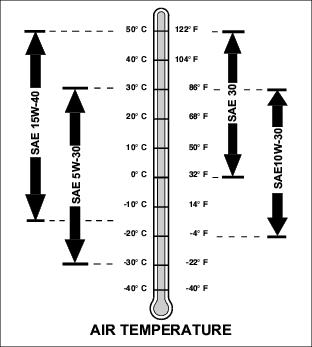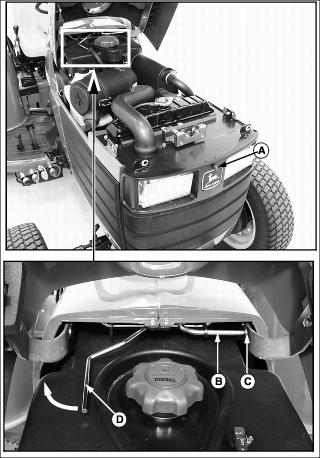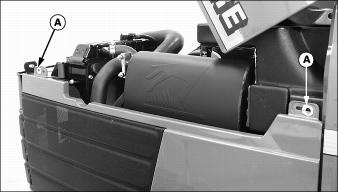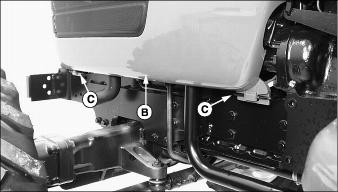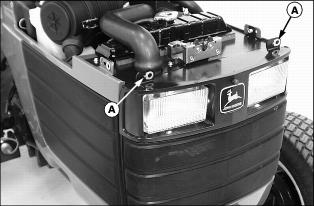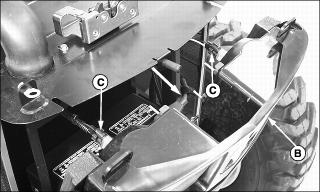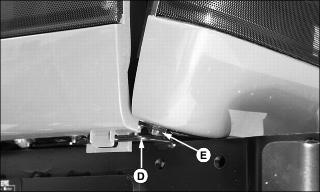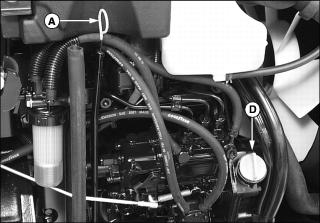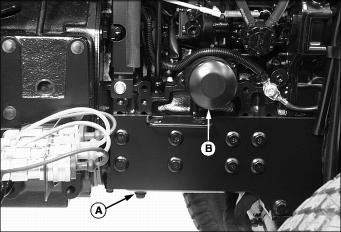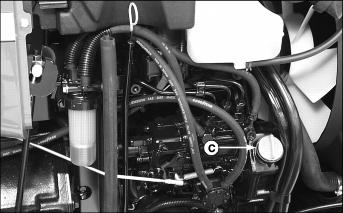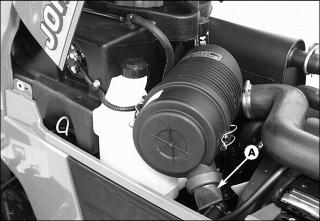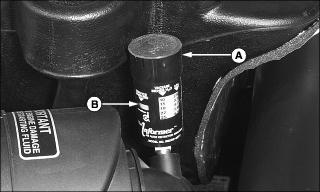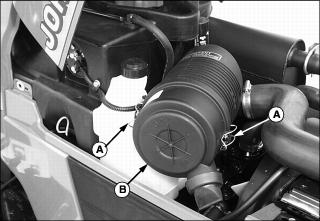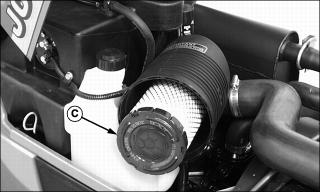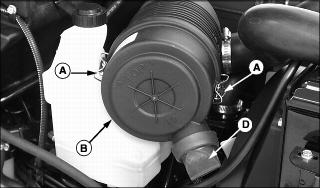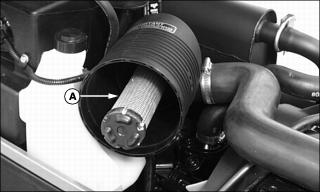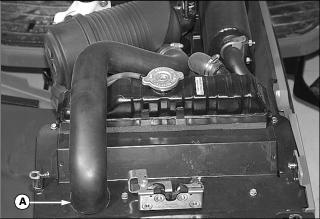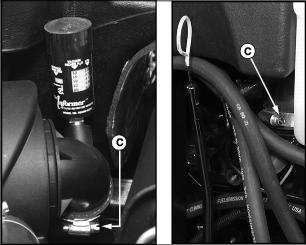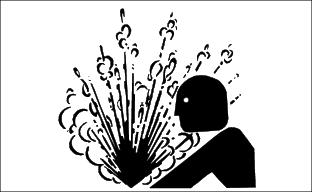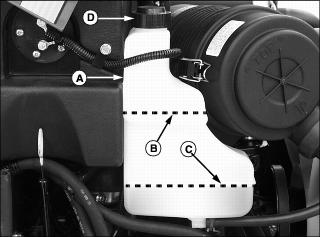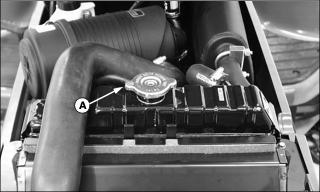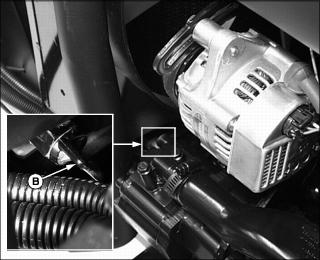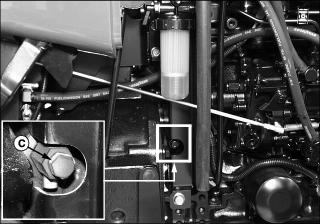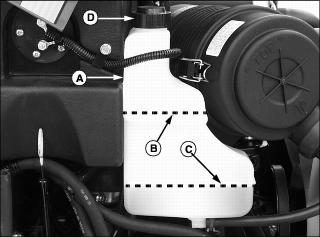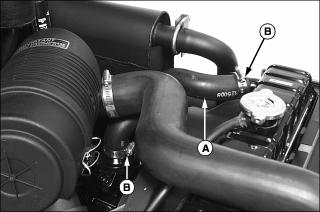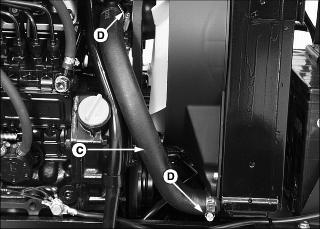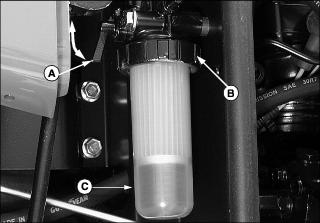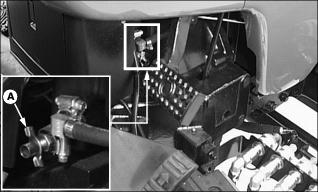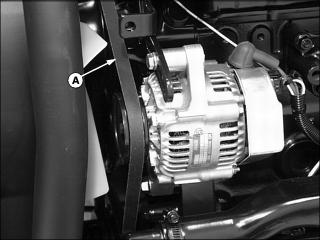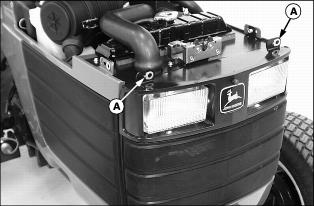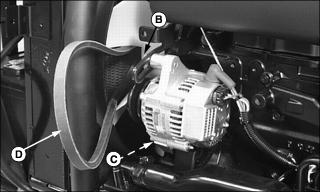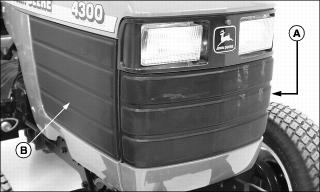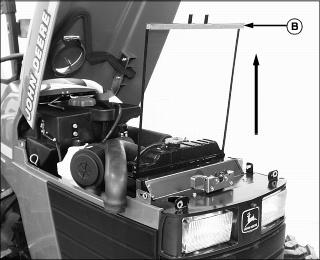PIN (122001-) (133001-) (144001-)
IntroductionProduct Identification
Safety
Operating
Replacement Parts
Service Intervals
Service Lubrication
Service Engine
Engine Warranty Maintenance Statement
Removing and Installing Engine Side Panels
Removing and Installing Front Grille
Changing Engine Oil and Filter
Cleaning Air Filter Dust Unloading Valve
Checking Air Restriction Indicator
Checking Air Filter Intake Hoses and Clamps
Checking Radiator Coolant Level
Checking Radiator Hoses and Clamps
Checking Fuel Filter Sediment Bowl
Cleaning Fuel Filter Sediment Bowl and Replacing Filter
Draining Water and Sediment From Fuel Tank
Cleaning Grille and Side Screens
Cleaning Radiator Cooling Screen
Cleaning Radiator Cooling Fins
Service Transmission
Service Electrical
Service Miscellaneous
Troubleshooting
Storage
Assembly
Specifications
Warranty
John Deere Quality Statement
Service Record

Service Engine
Engine Warranty Maintenance Statement
Maintenance, repair, or replacement of the emission control devices and systems on this engine, which are being done at the customers expense, may be performed by any non-road engine repair establishment or individual. Warranty repairs must be performed by an authorized John Deere dealer.
Avoid Fumes
Engine Oil
Checking Engine Speeds
Check engine speeds when engine is warmed up and not under load.
Observe tachometer.
· Slow idle (no load) - 950 rpm
· Fast idle (no load) - 2810 rpm
If above engine speeds are not to specifications, see your John Deere dealer.
Raising and Lowering Hood
Raising
1. Park machine safely. (See Parking Safely in the SAFETY section.)
2. Depress hood release button (A).
3. Raise hood until latch support rod (B) engages bracket hole (C).
Lowering
1. Lift hood slightly to remove weight from latch support rod.
2. Push latch release rod (D) outward to release support rod.
4. Push down on front of hood to lock latch.
Removing and Installing Engine Side Panels
Removing
1. Park machine safely. (See Parking Safely in the SAFETY section.)
3. Flip up and turn each spring loaded fastener (A) to the horizontal position.
4. Lift each side panel (B) off the two lower rod supports (C) to remove.
Installing
1. Install bottom of each side panel onto the two lower rod supports.
2. Install fasteners (A) through slots at the top of each panel. Turn each fastener vertical and flip down to secure panel in position.
Removing and Installing Front Grille
Removing
1. Park machine safely. (See Parking Safely in the SAFETY section.)
3. Flip up and turn spring loaded fasteners (A) to the horizontal position.
4. Carefully move top of grille (B) forward.
5. Disconnect wire harness (C) from each headlight assembly.
6. Lift grille so alignment tabs (E) are out of the rod supports (D) and remove.
Installing
1. Install alignment tabs at bottom of grill into each rod support.
2. Carefully move top of grille rearward.
3. Install fasteners through slots at top of grille. Turn each fastener vertical and flip down to secure grille in position.
Checking Engine Oil Level
NOTE: Check engine oil level when oil is cold.
1. Park the vehicle safely. (See Parking Safely in the SAFETY section.)
IMPORTANT: Avoid damage! Dirt and contamination can enter engine when checking oil level. Clean area around dipstick before removing. |
3. Remove dipstick (A). Wipe with a clean cloth.
6. Check oil level on dipstick; oil level should be between levels (B) and (C) on dipstick.
a. Remove side panel on right side of engine.
c. Add proper engine oil until oil level is within operating range on dipstick. Do not overfill.
8. If oil is above level (B) on the dipstick, drain to proper level.
Changing Engine Oil and Filter
1. Run engine to warm the oil.
2. Park machine safely. (See Parking Safely in the SAFETY section.)
4. Place container under oil drain located on right side of engine.
5. Remove side panel on right side of engine.
7. Wipe dirt from around oil filter (B).
8. Turn filter counter-clockwise to remove.
9. Put a light coat of clean engine oil on the gasket of new filter.
10. Install replacement oil filter by turning filter clockwise until gasket contacts filter base. Tighten additional one half turn.
11. Install drain plug. Do not overtighten.
· 4200 engine oil capacity is 3.8L (4.0 qt).
· 4300 and 4400 engine oil capacity is 4.3L (4.5 qt).
15. Start and run engine at idle to check for leaks.
16. Stop engine. Fix any leaks before operating.
17. Check engine oil level, add oil if necessary.
Cleaning Air Filter Dust Unloading Valve
IMPORTANT: Avoid damage! Prevent damage to the engine. Never operate engine without air cleaner elements and rubber dust unloading valve installed. |
1. Park machine safely. (See Parking Safely in the SAFETY section.)
3. Remove and clean rubber dust unloading valve (A). Replace if damaged.
Checking Air Restriction Indicator
1. Park machine safely. (See Parking Safely in the SAFETY section.)
NOTE: Indicator will not function correctly if plastic indicator housing is damaged.
3. Locate and check air restriction indicator (A).
· If window (B) shows yellow, no air cleaner service is required.
· If window (B) shows red, air cleaner requires immediate service.
4. Service air cleaner elements if needed.
5. Push reset button on air restriction indicator.
Servicing Air Cleaner Element
Servicing Primary Air Filter Element:
1. Park the vehicle safely. (See Park Safely in the SAFETY section.)
4. Release latches (A) and remove air cleaner canister cover (B).
5. Remove and discard primary element (C). Replace with a new primary filter element.
6. Install air cleaner canister cover (B) with rubber dust unloading valve (D) pointing downward.
7. Check instruction molded into canister cover for proper installation.
8. Hook latches (A) onto cover.
9. Push reset button (E) on air restriction indicator.
10. Start engine. Allow engine to run approximately one minute at maximum throttle speed.
12. Check air restriction indicator:
· If window (F) shows yellow, no air cleaner service is required.
· If window (F) shows red, air cleaner requires immediate service.
Servicing Secondary Air Filter Element:
1. Remove air cleaner canister cover.
2. Remove primary air filter element.
3. Remove and discard secondary air filter element (A). Replace with a new secondary air filter element.
4. Install primary air filter element.
5. Replace air cleaner canister cover.
6. Push reset button on air restriction indicator.
Checking Air Filter Intake Hoses and Clamps
1. Park machine safely. (See Parking Safely in the SAFETY section.)
3. Remove side panel from right side of engine.
NOTE: Upper air intake hose (A) must be properly installed into hole between radiator and grille.
4. Tighten upper air intake hose clamp (B).
5. Tighten lower air intake hose clamps (C).
Recommended Engine Coolant
The following John Deere coolants are preferred:
· COOL-GARD® PRE-DILUTED SUMMER COOLANT (TY16036).
· COOL-GARD® CONCENTRATED SUMMER COOLANT (TY16034).
If neither of the recommended coolants is available, use a glycol base coolant that meets the following specification:
Check container label before using to be sure it has the appropriate specifications for your machine. Use coolant with conditioner or add conditioner to coolant before using.
If using concentrate, mix approximately 50 percent antifreeze with 50 percent distilled or deionized water before adding to cooling system. This mixture will provide freeze protection to -37 degrees C (-34 degrees F).
Certain geographical areas may require lower temperature protection. See the label on your antifreeze container or consult your John Deere dealer to obtain the latest information and recommendations.
Checking Radiator Coolant Level
1. Park machine safely. (See Parking Safely in the SAFETY section.)
4. Remove service panel from right side of engine.
5. Check recovery tank (A) coolant level:
· If engine is warm, coolant level should be between the "H" (HIGH) line (B) and the "L" (LOW) line (C).
· If engine is cold, coolant level should be at the "L" (LOW) line (C) on the recovery tank.
6. Remove recovery tank cap (D) if necessary to add coolant.
7. Add pre-diluted coolant or specified ratio of antifreeze and water.
8. Install and tighten recovery tank cap.
Servicing Cooling System
Draining Cooling System
1. Park machine safely. (See Parking Safely in the SAFETY section.)
4. Remove both engine side panels.
5. Slowly open radiator cap (A) to the first stop to release all pressure.
6. Close radiator cap tightly.
7. Open radiator petcock (B). Drain coolant into a pan.
8. Position drain pan under engine block drain plug (C) at right side of engine. Remove drain plug and allow all coolant to drain.
9. When coolant drains from the recovery tank, remove radiator cap.
10. Close radiator petcock and install engine block drain plug.
Flushing Cooling System
1. Fill cooling system with clean water and John Deere Cooling System Cleaner, or John Deere Cooling System Quick Flush or an equivalent. Follow directions on the can.
2. Install and tighten radiator cap.
3. Start and run engine until it reaches operating temperature.
5. Open radiator petcock and remove engine block drain plug.
6. Drain cooling system immediately before rust and dirt settle.
7. Close radiator petcock and install engine block drain plug.
Filling Cooling System
NOTE: John Deere COOL-GARD coolant is recommended when adding new coolant to the cooling system.
Follow the directions on the container for correct mixture ratio.
· 4200 cooling system capacity is 5.3 L (5.6 qt).
· 4300 and 4400 cooling system capacity is 5.7 L
(6.1 qt).
3. Install and tighten radiator cap.
4. Run engine until it reaches operating temperature.
6. Check recovery tank (A) coolant level:
· If engine is warm, coolant level should be between the "H" (HIGH) line (B) and the "L" (LOW) line (C).
· If engine is cold, coolant level should be at the "L" (LOW) line (C) on the recovery tank.
7. Remove cap (D) from recovery tank to add coolant if necessary.
Checking Radiator Hoses and Clamps
1. Park machine safely. (See Parking Safely in the SAFETY section.)
3. Remove both engine side panels.
4. Check upper radiator hose (A) for damage or cracking. Replace if necessary.
5. Tighten hose clamps (B) as needed.
6. Check lower radiator hose (C) for damage or cracking. Replace if necessary.
7. Tighten hose clamps (D) as needed.
Checking Fuel Filter Sediment Bowl
1. Park machine safely. (See Parking Safely in the SAFETY section.)
4. Remove side panel from right side of engine.
NOTE: Red ring in bottom of sediment bowl will float on water. If ring is floating, sediment bowl should be cleaned.
5. Check for water and deposits in sediment bowl (A).
6. Clean sediment bowl and replace fuel filter if necessary.
Cleaning Fuel Filter Sediment Bowl and Replacing Filter
1. Park machine safely. (See Parking Safely in the SAFETY section.) Allow engine to cool.
3. Remove side panel from right side of engine.
4. Close fuel shut-off valve (A).
5. Position drain pan under fuel filter sediment bowl to catch fuel spillage.
6. Turn locking collar (B) counterclockwise to remove bowl (C).
7. Remove and discard the fuel filter.
8. Remove and retain the plastic ring and spring from sediment bowl.
9. Clean bowl, plastic ring, and spring.
10. Install plastic ring and spring in original position in sediment bowl.
11. Install new filter to filter head.
12. Place sediment bowl and locking collar in position.
13. Tighten locking collar to filter head to secure.
NOTE: Fuel system is self bleeding.
17. Crank engine to bleed fuel system.
Fuel Injection Pump
IMPORTANT: Avoid damage! Do not clean a warm or hot fuel injection pump with steam or water. Clean with compressed air if pump is not cooled. |
NOTE: The fuel injection pump is calibrated by the engine manufacturer and should not require any adjustments.
If engine is hard to start, lacks power, or runs rough, see Troubleshooting Section of this manual.
After performing the check in the troubleshooting section and your engine is still not performing correctly, contact your John Deere dealer.
Fuel Injection Nozzles
If injection nozzles are not working correctly or are dirty, engine will run poorly. See your John Deere dealer for service.
Draining Water and Sediment From Fuel Tank
1. Park machine safely. (See Parking Safely in the SAFETY section.)
Picture Note: Hydrostatic model shown
2. Locate petcock drain (A) behind the brake pedal(s) on the right side of the tractor.
3. Open petcock drain. Drain accumulated moisture and sediment from the fuel tank into a small container.
4. Close drain when fuel flow is clear.
Servicing the Alternator Belt
Checking Belt Tension
1. Park machine safely. (See Parking Safely in the SAFETY section.) Allow engine to cool.
3. Remove side panel from left side of engine.
4. Apply moderate thumb pressure to belt (A) halfway between the pulleys. Belt should deflect inward approximately 9mm (3/8 in.).
5. Adjust belt tension if deflection is more or less than specified.
Adjusting Belt Tension
3. Apply outward pressure to alternator housing until tension is correct.
Replacing Belt
NOTE: Replace alternator belt if excessive wear, damage or stretching is detected.
2. Flip up and turn spring loaded fasteners (A) to the horizontal position.
3. Carefully move top of grille forward.
4. Disconnect black negative (-) cable from battery.
5. Remove both engine side panels.
8. Apply inward pressure to alternator housing.
9. Remove belt (D) from alternator sheave, fan sheave and crankshaft sheave.
10. Route defective belt over fan and remove.
11. Install new belt over fan and onto sheaves.
12. Apply outward pressure to alternator housing until tension is correct.
13. Tighten bolts (B) and (C).
14. Check belt tension. Adjust as necessary.
15. Connect black negative (-) cable to battery.
17. Install both engine side panels.
Cleaning Grille and Side Screens
IMPORTANT: Avoid damage! Grille and side panel screens must be clean to prevent engine from overheating and to allow adequate air intake. |
1. Check grille (A) and both side panel screens (B) for dirt, grass clippings and debris.
2. Clean dirty grille and side screens with a brush or cloth.
Cleaning Radiator Cooling Screen
· Clear work area of bystanders. · Wear eye protection when using compressed air for cleaning purposes. |
IMPORTANT: Avoid damage! The radiator cooling screen must be clean to prevent engine from overheating and to allow adequate air intake. |
1. Park machine safely. (See Parking Safely in the SAFETY section.)
3. Remove air intake hose (A) from opening between the grille and radiator.
4. Lift and remove radiator screen (B).
5. Clean screen with compressed air, brush or cloth.
Cleaning Radiator Cooling Fins
· Clear work area of bystanders. · Wear eye protection when using compressed air for cleaning purposes. |
1. Park vehicle safely. (See Parking Safely in the SAFETY section.) Allow engine to cool.
3. Remove both engine side panels.
4. Remove radiator cooling screen.
6. Remove all dirt and debris from radiator fins (A) and fan shroud (B) using compressed air or water.
7. Clean radiator cooling screen.
8. Install radiator cooling screen.

